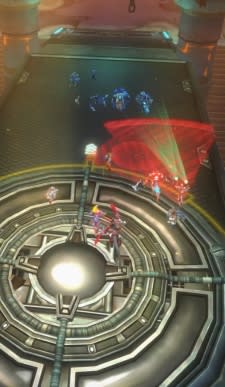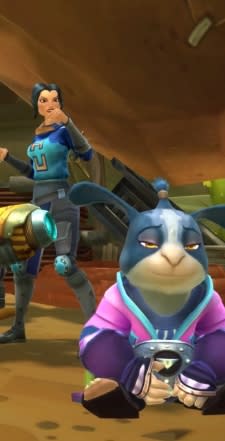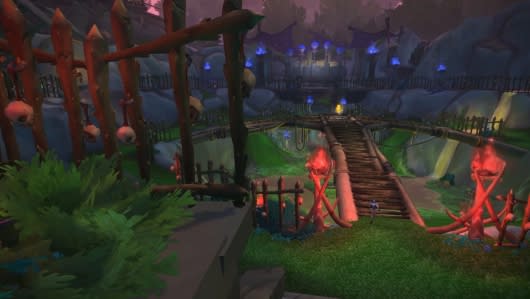Hands-on with WildStar's PvP
Oddly, for all that WildStar's development team has talked up combat, we've seen virtually nothing of the game's PvP beyond tantalizing promises. And beta tests, of course. Considering that the game's launch is in a couple of months, if you're pre-ordering you might want to know what you'll be getting yourself into. Which is why the team has, thankfully, produced a new DevSpeak video -- embedded past the cut -- that provides a top-level overview of the game's two most accessible PvP modes, Arenas and Battleground.
Normally, these are accompanied by lengthy question-and-answer sessions, but in this case I jumped in for one purpose and one purpose only: smashing heads. As a proud member of the Dominion, I was pitted against the filthy exiles in Walatiki Temple. So let's talk about how the match played, and how a few subtle twists on a relatively simple format combined to make the whole thing a much more invigorating experience than I'd expected.

When I first dropped into Walatiki Temple, I felt a sinking feeling in the pit of my stomach. Oh, spectacular, here's another battleground that serves as a game of capture-the-flag. I've only played those about a million times before. It seemed like an immediate failure of imagination, in other words. But then I actually started playing, and I realized that I was wrong; it's certainly of the same general species as capture the flag, but it's not quite the same.
Here are the basics. The goal is to accumulate five masks. Masks spawn periodically in a central location, producing the same sort of frenzied free-for-all you see in any PvP match that drops a victory resource in the center of the arena. At either end of the map are the factional bases, one for the Dominion and one for the Exiles.
Where it gets particularly interesting is that the bases also host the group's accumulated masks. This is where the capture-the-flag elements become very pronounced, because you can slip into the enemy base, retrieve a mask, and bring it back to your own collection.
It sounds pretty straightforward, like a minor twist, but it winds up significantly altering strategies and play. You can slip away from the grinding battle in the middle and try to swipe another mask from the other side's base, assuming they haven't left it defended. Of course, that means you're that much more likely to lose out on getting the mask that spawns in the center, unless you move more people in from defense... but then you run the risk of the other team slipping past your insufficient defenses...
More to the point, it creates an interesting dynamic in terms of advantage. Rather than one side establishing a decisive upper hand, there's room to come back. Committing fully to attacking one location leaves you with an extra level of vulnerability.
I was playing an Esper, which is a bit problematic on paper, since I haven't played one prior. However, my build (assembled in a few seconds) worked well enough, combining all of the things that I thought would be useful in a PvP match based on past experience -- area damage, stuns, snares, and a bit of group healing for the pinch. Despite that, it wound up feeling a bit different from the norm, because...
Well, let's be honest. I've played a lot of PvP matches wherein you try to click on something while everyone on the other team flings particle effects in your area to prevent you from clicking on it. If you have as well, you know what I'm talking about. It becomes a game of seeing who can spam the most area effects in the shortest span.

Things are a little different in WildStar. For one, the respawn timer is just a wee bit longer.
You might think this won't matter, but it has a notable impact over time: people are a lot more reluctant to die. Instead of a match in World of Warcraft, where dying just means a few seconds of running at most, dying in Walatiki Temple meant you'd be out of commission long enough to significantly turn the tide of a pitched battle. Which conveniently ties into the fact that because of the telegraph system, everything has an area effect. There are skills that just blast an area, but you can set up a pretty comprehensive zone of pain without them.
Combine that with knockbacks and telegraphs, and suddenly PvP gets another layer added on to it. Dodging enemy attacks is important, not just something you can do, and just throwing yourself against an objective like meat for the slaughter is a good way to lose. The core tactic of "stop that person from clicking on the thing" is intact, but the means of achieving that goal is a lot more involved than it is in most of the MMOs I've played prior.
Our team won the match, but it was a near thing. It involved doing stuff that I'd tried to do in the past without much success, like going in to bait a lone defender while someone else slipped in and grabbed a mask. I could dodge attacks and fire back just enough to make myself a more enticing target until my teammate got in. It made even the huge center battle feel natural and organic rather than like two masses of players running forward and colliding with one another for no distinct reason.
In short, it was fun.
I can't say for certain what the game's PvP scene will look like after the game launches, but as someone who greatly enjoys casual PvP, I have high hopes for it. Sure, a lot of the match types are broadly recognizable, but the details have been changed just enough that they feel a lot more fresh.

Massively's not big on scored reviews -- what use are those to ever-changing MMOs? That's why we bring you first impressions, previews, hands-on experiences, and even follow-up impressions for nearly every game we stumble across. First impressions count for a lot, but games evolve, so why shouldn't our opinions?


